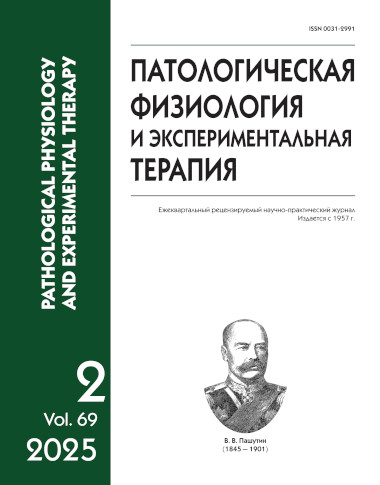The neuroprotective effect of argon-oxygen mixture inhalation 24 hours after ischemic stroke
Abstract
Introduction. Animal studies have shown that adding argon to the breathing mixture increases the survival of animals in models of cerebral hypoxia and ischemia. The important factors affecting the cell recovery after ischemic injury are the exposure time and dosage of argon. Studying the neuroprotective effect of argon 24 hours after the onset of stroke in an animal model will provide data on the feasibility of such delayed therapy. Aim. The study assessed the effect of three 2-hour inhalations of an argon-oxygen mixture (Ar 70%/O2 30%) 24 hours after photochemically induced stroke on the severity of neurological deficit and the volume of brain injury.
Methods. The experiments were performed on male Wistar rats weighing 250‒300 g (n=14). The animals were randomly divided into 3 groups based on the extent of the intervention: control group with ischemia + inhalation of N2 70%/O2 30% or Ischemia group, n=5; experimental group with ischemia + inhalation of Ar 70%/O2 30% (Ischemia+iAr group), n=6, and group of sham-operated animals (SO group), n=3. Neurological status was followed up for 14 days (limb support test). Magnetic resonance imaging (MRI) and immunohistochemistry were performed at 14 days after ischemia.
Results. No statistically significant differences were found between the experimental groups. The mean volume of injury in the Ischemia+iAr group and Ischemia group was 19.5 (16.5; 22.7) mm3 and 22.0 (18.0; 23.7) mm3, respectively (p=0.12). The area of vWF-positive staining in the Ischemia+iAr group was somewhat greater than in the Ischemia group (0.18 [0.15; 0.20] vs. 0.16 [0.14; 0.18], p=0.054); however, the difference was not significant. The number of Cas-3-positive cells was decreased in the Ischemia+iAr group (10384 [9586; 12685]) compared to the Ischemia group (13856 [11548; 18295], p=0.068).
Conclusion. Three-time 2-hour inhalation of the argon-oxygen mixture (Ar 70%/O2 30%) 24 hours after photochemically induced stroke does not reduce the severity of neurological deficit or reduce the volume of injury.






